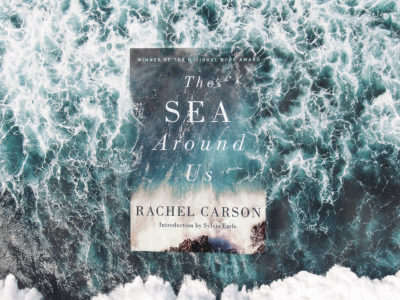Rachel Carson has forever changed the way I see the ocean, and I don’t know how she did it.
I was going to give you some passages depicting the ocean as a mother: who unceasingly circulates her bodily currents across distant shores and open seas, from lightless deep to windswept surface; all in service to the seasonal birthing and nurturing of the myriad marine species she harbors within the whole of her being – but I couldn’t find any.
Maybe I missed them when I looked back, or maybe after reading so many of her signature lyrical, scientific descriptions of life in and around the ocean, it was easy to imagine. Either way, I’ve included some other lovely passages from The Sea Around Us that I hope you’ll enjoy.
Rachel Carson is most famous for writing Silent Spring, the book that simultaneously ended DDT production in the U.S. and sparked the environmental movement. (A must-read, if you haven’t already.) As a marine biologist, though, her real passion was for the ocean and that comes through clearly in The Sea Around Us – a lovely, though scientifically dated, read if you’re wanting to be more in tune with the ocean.
“For the sea as a whole, the alternation of day and night, the passage of the seasons, the procession of the years, are lost in its vastness, obliterated in its own changeless eternity. But the surface waters are different. The face of the sea is always changing. Crossed by colors, lights, and moving shadows, sparkling in the sun, mysterious in the twilight, its aspects and its moods vary hour by hour. The surface waters move with the tides, stir to the breath of the winds, and rise and fall to the endless, hurrying forms of the waves. Most of all, they change with the advance of the seasons.”
“The permanent currents of the ocean are, in a way, the most majestic of her phenomena. Reflecting upon them, our minds are at once taken out from the earth so that we can regard, as from another planet, the spinning of the globe, the winds that deeply trouble its surface or gently encompass it, and the influence of the sun and the moon. For all these cosmic forces are closely linked with the great currents of the ocean, earning for them the adjective I like best of all those applied to them – the planetary currents.”
“There is, then, no water that is wholly of the Pacific, or wholly of the Atlantic, or of the Indian or the Antarctic. The surf that we find exhilarating at Virginia Beach or at La Jolla today may have lapped at the base of Antarctic icebergs or sparkled in the Mediterranean sun, years ago, before it moved through dark and unseen waterways to the place we find it now. It is by the deep, hidden currents that the oceans are made one.”
Rachel Carson, The Sea Around Us
* Base layer ocean photo by Inés Álvarez Fdez on Unsplash


 How Marie Kondo Helped Me Hear My Heart (this is not about tidying)
How Marie Kondo Helped Me Hear My Heart (this is not about tidying)